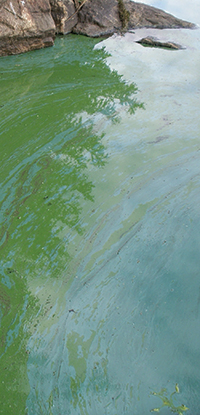 In Bloom: The science & consequences of dangerous blue-green algae
In Bloom: The science & consequences of dangerous blue-green algae
In Wisconsin, summer means soaking in the sun and enjoying outdoor activities on one of the state’s 15,000 lakes. However, this Memorial Day my family arrived at our cottage west of Shawano to find something that has become far too common: the lake was coated with a pale-green, smelly scum. After contacting regional scientists at the Wisconsin DNR, we were informed that the lake was experiencing a blue-green algae bloom.
Actually a bacteria called cyanobacteria, blue-green algae is almost always present in Wisconsin lakes, but its quantity is kept in check by other aquatic organisms such as zooplankton and a limited amount of nutrients essential for growth, like phosphorous and nitrogen. However, when there are excess nutrients, an abundance of sunlight and calm water, the conditions become right for cyanobacteria to grow exponentially. Discharge from water treatment and food-processing plants, fertilizer runoff from fields, and leaching from animal waste are some of the biggest contributors of excess nutrients in Wisconsin lakes.
Aside from the foul smell and ugly appearance, the negative consequences of algal blooms are far-reaching. Algae mats block sunlight from reaching underwater plants and plankton that provide food and habitat for aquatic organisms. Oxygen levels consequently decline as aquatic plant photosynthesis is restricted, resulting in hypoxic (low-oxygen) conditions. The cyanobacteria themselves use oxygen for respiration, and the decomposition of these blooms further exacerbates the hypoxic conditions, diminishing the water body’s ability to support certain aquatic organisms. If these conditions persist, a dead zone can be formed where little to no animal life can survive. The second largest dead zone in the world is at the mouth of the Mississippi River in the northern Gulf of Mexico. In Wisconsin, the bay of Green Bay has developed its own dead zone in recent years.
The adverse effects of algal blooms are not limited to aquatic life. Some blue-green algae can produce toxins that are harmful to humans and other organisms. If exposed to algal toxins, humans and pets can experience rashes, vomiting, diarrhea, respiratory illness, and liver damage. Pets are particularly susceptible to the dangers of blue-green algae because of their smaller size and tendency to lick their fur, which may be contaminated. Because true algae, like green algae, and dangerous blue-green algae can also bloom in similar conditions, look similar and are often found together, a precautionary approach is best. As the saying goes, “When in doubt, stay out,” and instead find clean areas of water and avoid swimming, boating, and fishing in algae and keep pets from coming in contact with algae.
In addition to detrimental environmental and health effects, algal blooms can have significant economic consequences, including tourism loss, decreased property values and higher drinking water treatment costs. For instance, areas in Minnesota saw water treatment costs rise fortyfold when their drinking water supply was plagued by an algal bloom.
Over the years, Clean Wisconsin has worked hard to combat harmful algal blooms in Wisconsin’s waters. In 2010, Clean Wisconsin helped Wisconsin become a national leader on phosphorus management strategies when the DNR adopted the Phosphorus Rules. Luckily, you do not have to be an environmental advocacy group or state agency to make a difference when it comes to algal blooms.
You can help reduce the amount of polluting nutrients that accumulate in the water by:
- Minimizing personal use of fertilizers
- Preventing organic matter (yard clippings and pet waste) from decomposing in the water
- Planting and maintaining a vegetative buffer zone along shorelines to filter runoff
Following these strategies can help make prevent unwanted green slime from spoiling your plans to enjoy your favorite Wisconsin lake on a gorgeous summer day.
